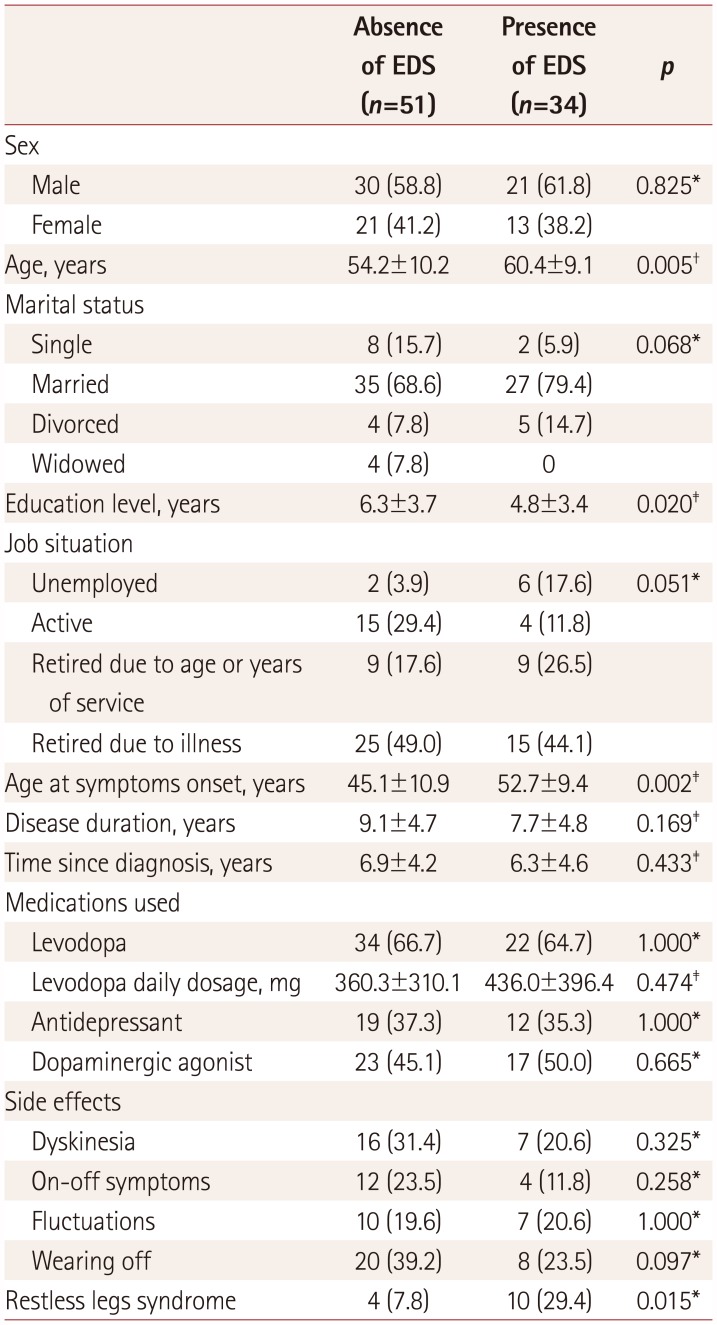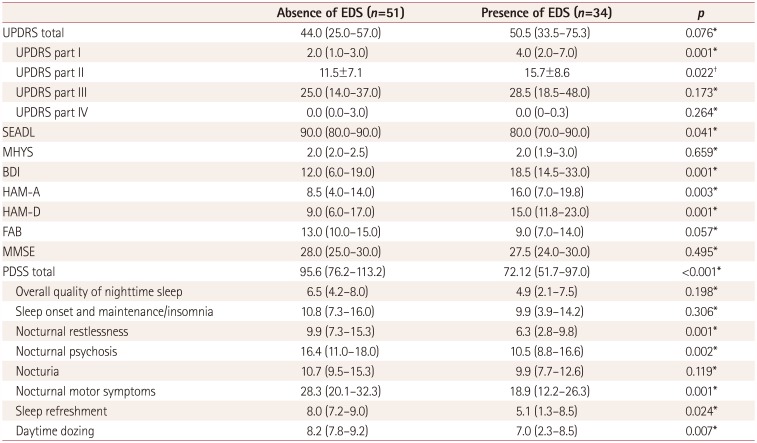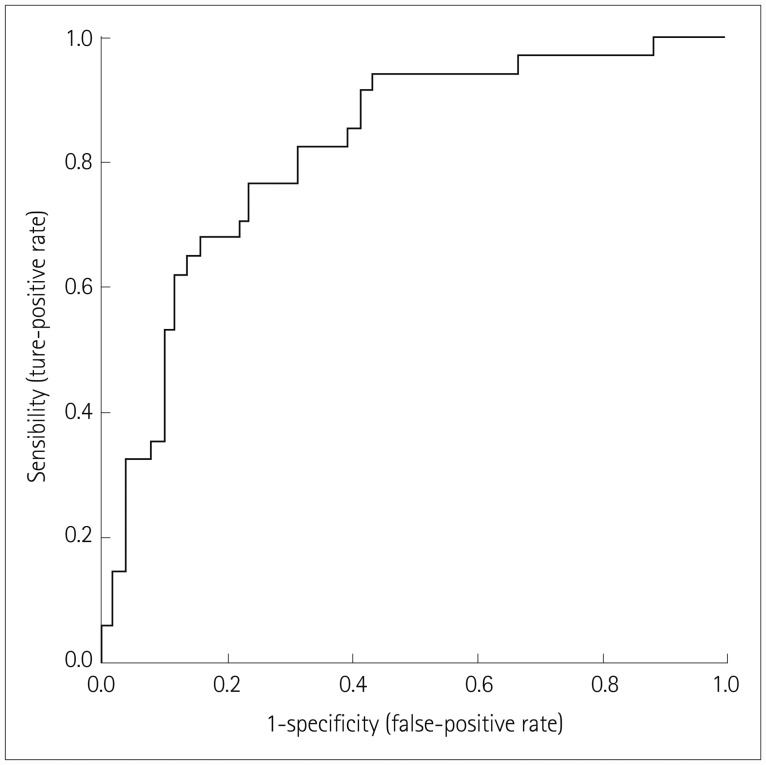1. Dhawan V, Healy DG, Pal S, Chaudhuri KR. Sleep-related problems of Parkinson's disease. Age Ageing. 2006; 35:220–228. PMID:
16638765.

2. Alatriste-Booth V, Rodríguez-Violante M, Camacho-Ordoñez A, Cervantes-Arriaga A. Prevalence and correlates of sleep disorders in Parkinson's disease: a polysomnographic study. Arq Neuropsiquiatr. 2015; 73:241–245. PMID:
25807131.

3. Suzuki K, Okuma Y, Uchiyama T, Miyamoto M, Sakakibara R, Shimo Y, et al. Impact of sleep-related symptoms on clinical motor subtypes and disability in Parkinson's disease: a multicentre cross-sectional study. J Neurol Neurosurg Psychiatry. 2017; 88:953–959. PMID:
28847794.

4. Junho BT, Kummer A, Cardoso FE, Teixeira AL, Rocha NP. Sleep quality is associated with the severity of clinical symptoms in Parkinson's disease. Acta Neurol Belg. 2018; 118:85–91. PMID:
29210000.

5. Chahine LM, Amara AW, Videnovic A. A systematic review of the literature on disorders of sleep and wakefulness in Parkinson's disease from 2005 to 2015. Sleep Med Rev. 2017; 35:33–50. PMID:
27863901.

6. American Academy of Sleep Medicine. International Classification of Sleep Disorders. Darien, IL: American Academy of Sleep Medicine;2014.
7. Amara AW, Chahine LM, Caspell-Garcia C, Long JD, Coffey C, Högl B, et al. Longitudinal assessment of excessive daytime sleepiness in early Parkinson's disease. J Neurol Neurosurg Psychiatry. 2017; 88:653–662. PMID:
28554959.

8. Arnulf I, Konofal E, Merino-Andreu M, Houeto JL, Mesnage V, Welter ML, et al. Parkinson's disease and sleepiness: an integral part of PD. Neurology. 2002; 58:1019–1024. PMID:
11940685.

9. Simuni T, Caspell-Garcia C, Coffey C, Chahine LM, Lasch S, Oertel WH, et al. Correlates of excessive daytime sleepiness in de novo Parkinson's disease: a case control study. Mov Disord. 2015; 30:1371–1381. PMID:
26095202.

10. Chondrogiorgi M, Tzarouchi LC, Zikou AK, Astrakas LG, Kosta P, Argyropoulou MI, et al. Multimodal imaging evaluation of excessive daytime sleepiness in Parkinson's disease. Int J Neurosci. 2016; 126:422–428. PMID:
26000811.

11. Wen MC, Ng SY, Heng HS, Chao YX, Chan LL, Tan EK, et al. Neural substrates of excessive daytime sleepiness in early drug naïve Parkinson's disease: a resting state functional MRI study. Parkinsonism Relat Disord. 2016; 24:63–68. PMID:
26810915.

12. Chung S, Bohnen NI, Albin RL, Frey KA, Müller ML, Chervin RD. Insomnia and sleepiness in Parkinson disease: associations with symptoms and comorbidities. J Clin Sleep Med. 2013; 9:1131–1137. PMID:
24235893.

13. Comella CL. Sleep disturbances and excessive daytime sleepiness in Parkinson disease: an overview. J Neural Transm Suppl. 2006; 349–355. PMID:
17017552.

14. Verbaan D, van Rooden SM, Visser M, Marinus J, van Hilten JJ. Nighttime sleep problems and daytime sleepiness in Parkinson's disease. Mov Disord. 2008; 23:35–41. PMID:
17960797.

15. Havlikova E, van Dijk JP, Nagyova I, Rosenberger J, Middel B, Dubayova T, et al. The impact of sleep and mood disorders on quality of life in Parkinson's disease patients. J Neurol. 2011; 258:2222–2229. PMID:
21614432.

16. Zhu K, van Hilten JJ, Marinus J. Onset and evolution of anxiety in Parkinson's disease. Eur J Neurol. 2017; 24:404–411. PMID:
28032408.

17. Tholfsen LK, Larsen JP, Schulz J, Tysnes OB, Gjerstad MD. Development of excessive daytime sleepiness in early Parkinson disease. Neurology. 2015; 85:162–168. PMID:
26085603.

18. Lenka A, George L, Arumugham SS, Hegde S, Reddy V, Kamble N, et al. Predictors of onset of psychosis in patients with Parkinson's disease: who gets it early? Parkinsonism Relat Disord. 2017; 44:91–94. PMID:
28928050.

19. Spindler M, Gooneratne NS, Siderowf A, Duda JE, Cantor C, Dahodwala N. Daytime sleepiness is associated with falls in Parkinson's disease. J Parkinsons Dis. 2013; 3:387–391. PMID:
23948992.

20. Zhu K, van Hilten JJ, Marinus J. Predictors of dementia in Parkinson's disease; findings from a 5-year prospective study using the SCOPA-COG. Parkinsonism Relat Disord. 2014; 20:980–985. PMID:
25024059.

21. Kummer A, Scalzo P, Cardoso F, Teixeira AL. Evaluation of fatigue in Parkinson's disease using the Brazilian version of Parkinson's Fatigue Scale. Acta Neurol Scand. 2011; 123:130–136. PMID:
20456242.

22. Avidan A, Hays RD, Diaz N, Bordelon Y, Thompson AW, Vassar SD, et al. Associations of sleep disturbance symptoms with health-related quality of life in Parkinson's disease. J Neuropsychiatry Clin Neurosci. 2013; 25:319–326. PMID:
24247858.

23. Gallagher DA, Lees AJ, Schrag A. What are the most important nonmotor symptoms in patients with Parkinson's disease and are we missing them? Mov Disord. 2010; 25:2493–2500. PMID:
20922807.

24. Ozdilek B, Gunal DI. Motor and non-motor symptoms in Turkish patients with Parkinson's disease affecting family caregiver burden and quality of life. J Neuropsychiatry Clin Neurosci. 2012; 24:478–483. PMID:
23224455.

25. Hughes AJ, Daniel SE, Kilford L, Lees AJ. Accuracy of clinical diagnosis of idiopathic Parkinson's disease: a clinico-pathological study of 100 cases. J Neurol Neurosurg Psychiatry. 1992; 55:181–184. PMID:
1564476.

26. Fahn S, Elton R. Unified Parkinson's disease rating scale. In : Fahn S, Marsden CD, Jenner P, Teychenne P, editors. Recent Developments in Parkinson's Disease. Florham Park, NJ: Macmillan Health Care Information;1987. p. 153–163.
27. Goetz CG, Poewe W, Rascol O, Sampaio C, Stebbins GT, Counsell C, et al. Movement Disorder Society Task Force report on the Hoehn and Yahr staging scale: status and recommendations. Mov Disord. 2004; 19:1020–1028. PMID:
15372591.
28. Johns MW. A new method for measuring daytime sleepiness: the Epworth sleepiness scale. Sleep. 1991; 14:540–545. PMID:
1798888.

29. Chaudhuri KR, Pal S, DiMarco A, Whately-Smith C, Bridgman K, Mathew R, et al. The Parkinson's disease sleep scale: a new instrument for assessing sleep and nocturnal disability in Parkinson's disease. J Neurol Neurosurg Psychiatry. 2002; 73:629–635. PMID:
12438461.

30. Chaudhuri KR, Martinez-Martin P. Clinical assessment of nocturnal disability in Parkinson's disease: the Parkinson's Disease Sleep Scale. Neurology. 2004; 63(8 Suppl 3):S17–S20. PMID:
15505136.

31. Folstein MF, Robins LN, Helzer JE. The mini-mental state examination. Arch Gen Psychiatry. 1983; 40:812. PMID:
6860082.

32. Dubois B, Slachevsky A, Litvan I, Pillon B. The FAB: a frontal assessment battery at bedside. Neurology. 2000; 55:1621–1626. PMID:
11113214.

33. Beck AT, Ward CH, Mendelson M, Mock J, Erbaugh J. An inventory for measuring depression. Arch Gen Psychiatry. 1961; 4:561–571. PMID:
13688369.

34. Hamilton M. A rating scale for depression. J Neurol Neurosurg Psychiatry. 1960; 23:56–62. PMID:
14399272.

35. Hamilton M. The assessment of anxiety states by rating. Br J Med Psychol. 1959; 32:50–55. PMID:
13638508.

36. McRae C, Diem G, Vo A, O'Brien C, Seeberger L. Reliability of measurements of patient health status: a comparison of physician, patient, and caregiver ratings. Parkinsonism Relat Disord. 2002; 8:187–192. PMID:
12039430.

37. Allen RP, Picchietti D, Hening WA, Trenkwalder C, Walters AS, Montplaisi J, et al. Restless legs syndrome: diagnostic criteria, special considerations, and epidemiology. A report from the restless legs syndrome diagnosis and epidemiology workshop at the National Institutes of Health. Sleep Med. 2003; 4:101–119. PMID:
14592341.
38. Edwards BA, O'Driscoll DM, Ali A, Jordan AS, Trinder J, Malhotra A. Aging and sleep: physiology and pathophysiology. Semin Respir Crit Care Med. 2010; 31:618–633. PMID:
20941662.

39. Mander BA, Winer JR, Walker MP. Sleep and human aging. Neuron. 2017; 94:19–36. PMID:
28384471.

40. Wolkove N, Elkholy O, Baltzan M, Palayew M. Sleep and aging: 1. sleep disorders commonly found in older people. CMAJ. 2007; 176:1299–1304. PMID:
17452665.

41. Schmidt C, Peigneux P, Cajochen C. Age-related changes in sleep and circadian rhythms: impact on cognitive performance and underlying neuroanatomical networks. Front Neurol. 2012; 3:118. PMID:
22855682.

42. Vashum KP, McEvoy MA, Hancock SJ, Islam MR, Peel R, Attia JR, et al. Prevalence of and associations with excessive daytime sleepiness in an Australian older population. Asia Pac J Public Health. 2015; 27:NP2275–NP2284. PMID:
24097933.

43. Ohayon MM, Vecchierini MF. Daytime sleepiness and cognitive impairment in the elderly population. Arch Intern Med. 2002; 162:201–208. PMID:
11802754.

44. Empana JP, Dauvilliers Y, Dartigues JF, Ritchie K, Gariepy J, Jouven X, et al. Excessive daytime sleepiness is an independent risk indicator for cardiovascular mortality in community-dwelling elderly: the three city study. Stroke. 2009; 40:1219–1224. PMID:
19246707.
45. Hays JC, Blazer DG, Foley DJ. Risk of napping: excessive daytime sleepiness and mortality in an older community population. J Am Geriatr Soc. 1996; 44:693–698. PMID:
8642162.

46. Braak H, Del Tredici K, Rüb U, de Vos RA, Jansen Steur EN, Braak E. Staging of brain pathology related to sporadic Parkinson's disease. Neurobiol Aging. 2003; 24:197–211. PMID:
12498954.

47. Gama RL, Távora DG, Bomfim RC, Silva CE, de Bruin VM, de Bruin PF. Sleep disturbances and brain MRI morphometry in Parkinson's disease, multiple system atrophy and progressive supranuclear palsya comparative study. Parkinsonism Relat Disord. 2010; 16:275–279. PMID:
20185356.
48. Gjerstad MD, Alves G, Wentzel-Larsen T, Aarsland D, Larsen JP. Excessive daytime sleepiness in Parkinson disease: is it the drugs or the disease? Neurology. 2006; 67:853–858. PMID:
16966550.

49. de la Riva P, Smith K, Xie SX, Weintraub D. Course of psychiatric symptoms and global cognition in early Parkinson disease. Neurology. 2014; 83:1096–1103. PMID:
25128183.

50. Wijemanne S, Ondo W. Restless Legs Syndrome: clinical features, diagnosis and a practical approach to management. Pract Neurol. 2017; 17:444–452. PMID:
29097554.

51. Suzuki K, Okuma Y, Uchiyama T, Miyamoto M, Sakakibara R, Shimo Y, et al. Characterizing restless legs syndrome and leg motor restlessness in patients with Parkinson's disease: a multicenter case-controlled study. Parkinsonism Relat Disord. 2017; 44:18–22. PMID:
28827009.

52. Yamanishi T, Tachibana H, Oguru M, Matsui K, Toda K, Okuda B, et al. Anxiety and depression in patients with Parkinson's disease. Intern Med. 2013; 52:539–545. PMID:
23448761.

53. Shulman LM, Taback RL, Rabinstein AA, Weiner WJ. Non-recognition of depression and other non-motor symptoms in Parkinson's disease. Parkinsonism Relat Disord. 2002; 8:193–197. PMID:
12039431.

54. Ghorayeb I, Loundou A, Auquier P, Dauvilliers Y, Bioulac B, Tison F. A nationwide survey of excessive daytime sleepiness in Parkinson's disease in France. Mov Disord. 2007; 22:1567–1572. PMID:
17534963.









 PDF
PDF ePub
ePub Citation
Citation Print
Print


 XML Download
XML Download